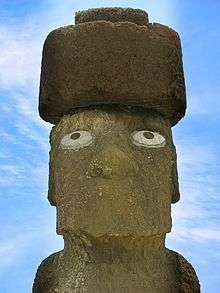Pukao
Pukao are the hat-like structures or topknots formerly placed on top of some moai statues on Easter Island.[1] They were all carved from a very light-red volcanic scoria, which was quarried from a single source at Puna Pau.

Symbolism
Pukao were not made until the 15th - 16th centuries and are later additions to the moai.[2] The reason that pukao were made is not known, though various theories exist. One is that the placing of a pukao on top of the moai was a recognition of the power of the individual represented. This has credibility because such a task at the time was, and even now is, extremely difficult, especially because no evidence has been found of crane technology existing at the time.[3] Another theory is that the pukao serve to distinguish between statues. Those moai with pukao are meant to be shown as more majestic and important. This distinction may have also indicated to islanders those statues at which various rituals should be performed.[4] Pukao are now believed to represent hair[5] because it was the custom for high-ranking men to have long hair tied in a bun on the top of their heads.[2]
Construction
Pukao are cylindrical in shape, with a dent on the underside to fit on the head of the moai and a boss or knot on top. They fit onto the moai in such a way that the pukao protrudes forwards. Their size varies in proportion to the moai they were on, but they can be from 6 to 10 feet (1.8 to 3.0 metres) in diameter.[1] Pukao weigh up to 10 tonnes (11 short tons), and the placement of a pukao on top of a moai raised the height of the statues to an average of 11 m (37 ft).[6]
The pukao was balanced as a separate piece on top of the head of a moai. They are believed to have been raised using ramps, possibly requiring only several people. The ring-like indentations along the bottom and edges of the pukao support this theory, as they postulate a ramp made out of logs being used to roll the pukao to the tops of moai statues. In addition, various physicists have made models indicating that this as a possibility, and, given the oblong shape of pukao, the structures would have been easier to roll up the statue than roll back down. However, no one theory can be accepted as correct, because virtually any theorized method (such as the use of pulleys) is plausible.[5]
To date, about 100 pukao have been documented archaeologically, but only at Ahu with fallen statues or at the source quarry.
Source of the Pukao
The red-colored hats were made from reddish scoria, a volcanic rock.[7] The rocks were sourced from a quarry known as Puna Pau, which was located inside the crater of a volcano with the same name, and on its outer lip. After the Pukao were made, they were rolled by hand or on tree logs along an ancient road to the site of the statues. The road was built out of a cement of compressed red scoria dust.[8] Over 70 discarded Pukao have been found along the road and on raised ceremonial platforms.[8] The indents found on the bottom of pukao that reached the statutes are not present in those strewn along the path from Puna Pau to the moai, hinting that basic quarrying was done at Puna Pau, as well as moulding the stone into a cylindrical shape easier to transport. Meanwhile, more intricate carvings were made at the site of the moai, immediately prior to the placement of pukao on the statues.[2]
See also
Notes
- "The Pukao of Puna Pau - Easter Island". www.southamerica.cl. Retrieved 2016-02-21.
- "PUNA PAU - PUKAO QUARRY | Imagina Easter Island". Imagina Easter Island (in Spanish). Retrieved 2016-03-01.
- Diamond, Jared M. (2006-01-01). Collapse: How Societies Choose to Fail Or Succeed. Penguin. ISBN 9780143036555.
- Arnold, Caroline (2004-10-01). Easter Island: Giant Stone Statues Tell of a Rich and Tragic Past. Houghton Mifflin Harcourt. ISBN 0618486054.
- "Giant Easter Island 'Hats' Rolled Into Place, Study Says". LiveScience.com. Retrieved 2016-02-21.
- "Easter Island | island, Chile". Encyclopædia Britannica. Retrieved 2016-03-03.
- Hamilton, Sue (2007). Stone Worlds: Narrative and Reflexive in Landscape Archaeology. Walnut Creek, CA: Left Coast Press. ISBN 978-1-59874-218-3.
- Discovery News. "Easter Island Red Hat Mystery Revealed". The ancient mystery of the distinctive red hats atop the Easter Island statues has been solved. Retrieved 29 November 2011.
Sources
- Jared Diamond Collapse: How Societies Choose to Fail or Succeed 2005 Viking Press ISBN 0-670-03337-5, 2006 Penguin ISBN 0-14-027951-2
- Grant McCall (1995). "Rapanui (Easter Island)." Pacific Islands Year Book 17th Edition. Fiji Times. Retrieved August 8, 2005.
- Jo Anne Van Tilburg Easter Island Archaeology, Ecology and Culture 1994 British Museum Press ISBN 0-7141-2504-0, 1995 Smithsonian Press ISBN 1-56098-510-0
- Easter Island statue project
- Katherine Routledge. 1919. The Mystery of Easter Island. The story of an expedition. London.
- "Puna Pau - Pukao." The Pukao of Puna Pau. Web. 20 Feb. 2016. http://www.southamerica.cl/easter-island/puna-pau- pukao.htm
External links
- Splendid Isolation: Art of Easter Island, an exhibition catalog from The Metropolitan Museum of Art (fully available online as PDF), which contains material on Pukao
